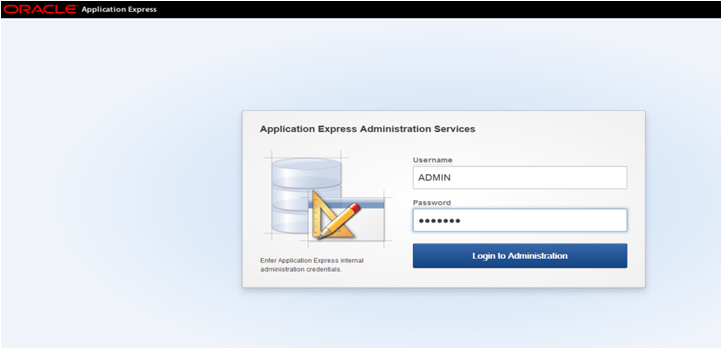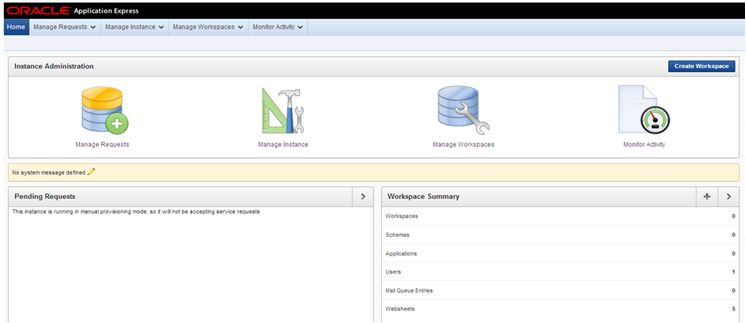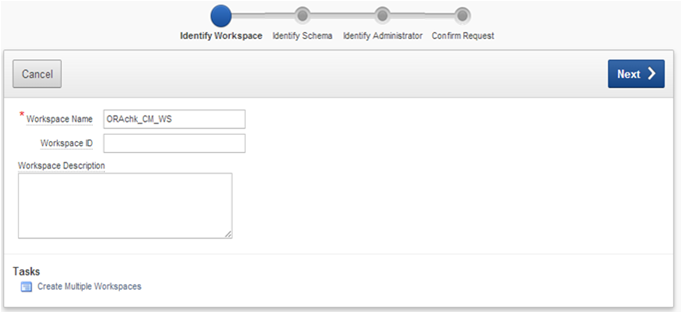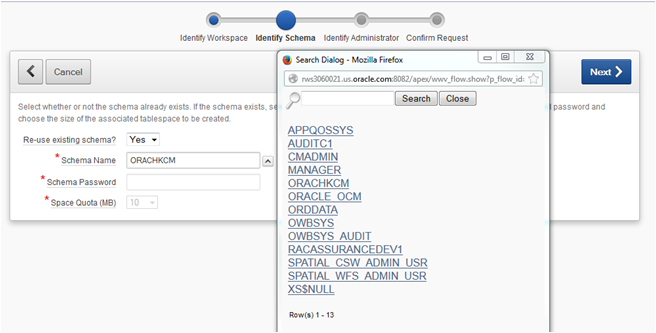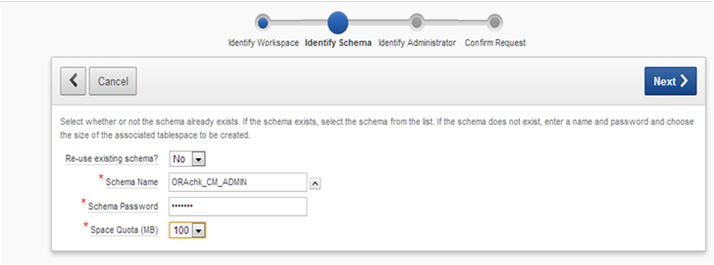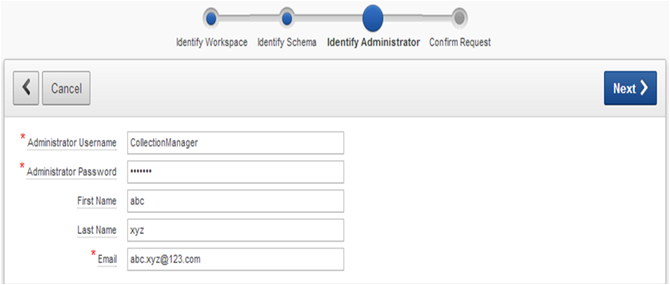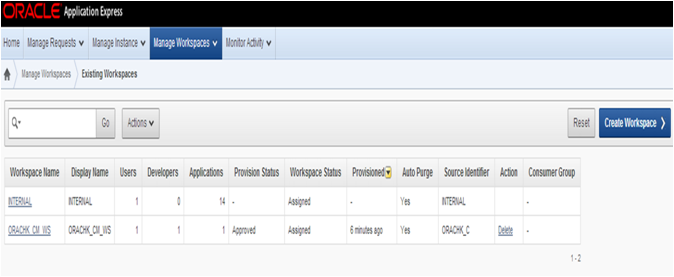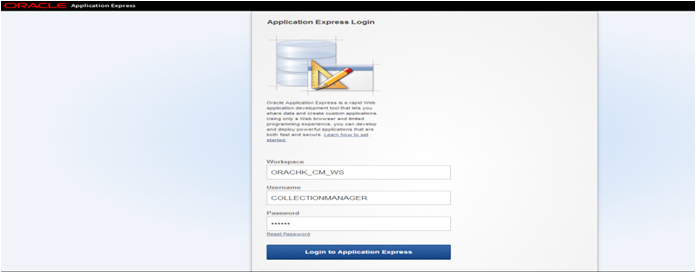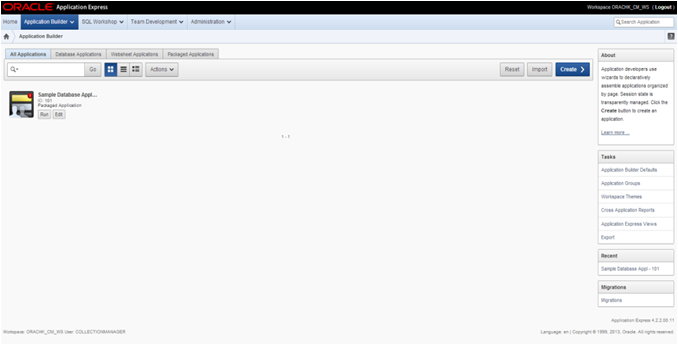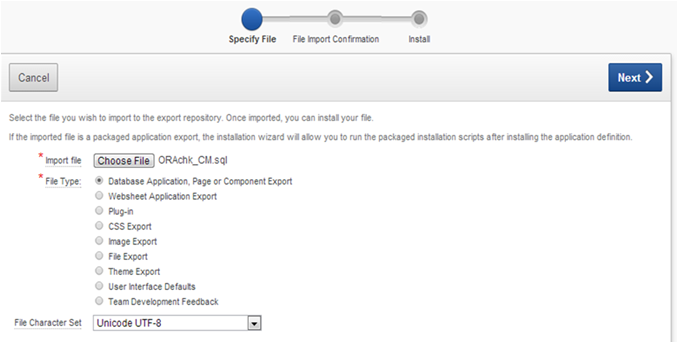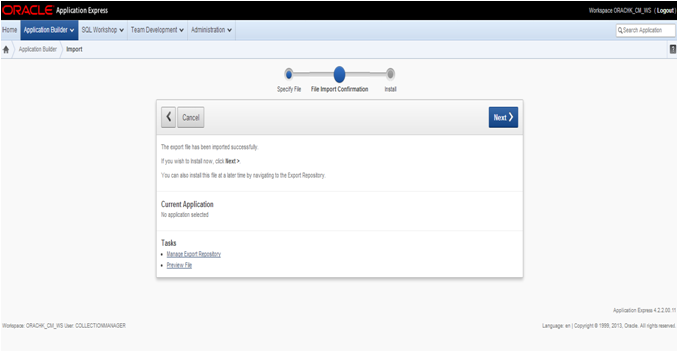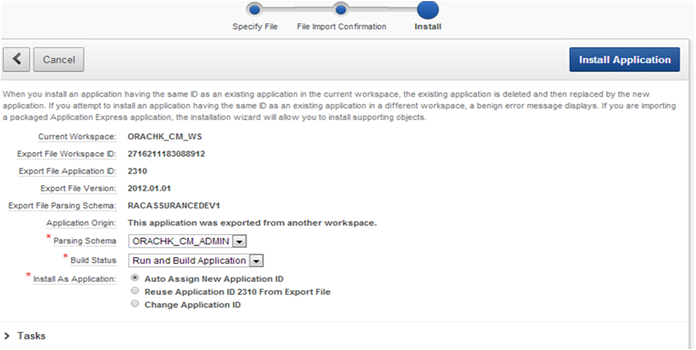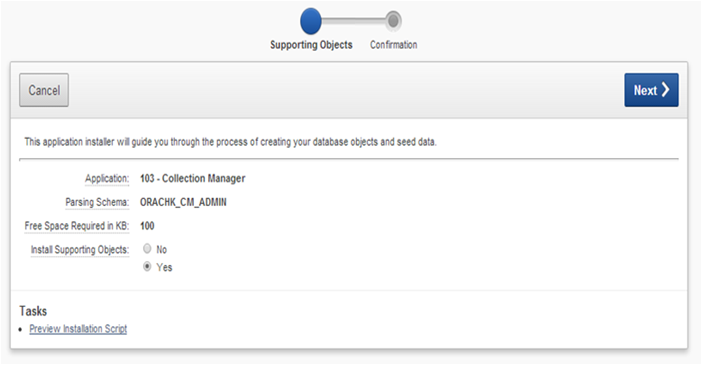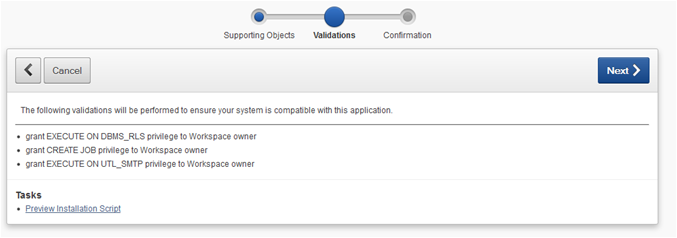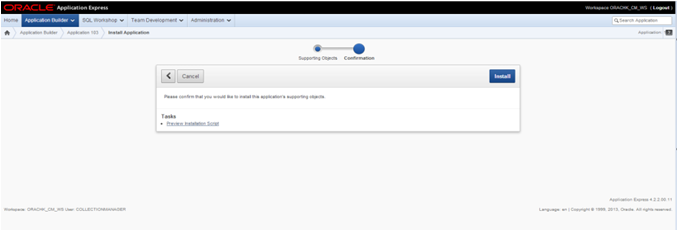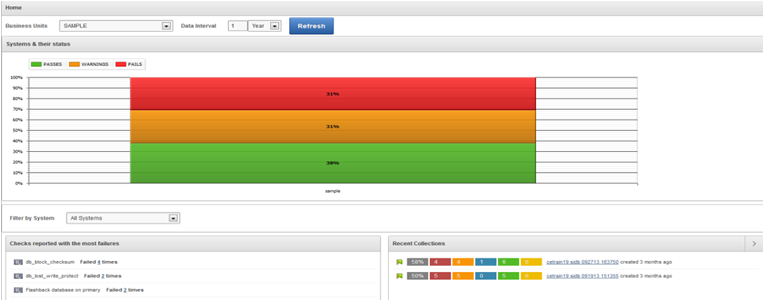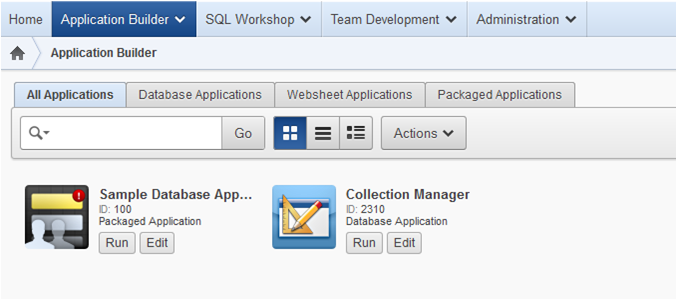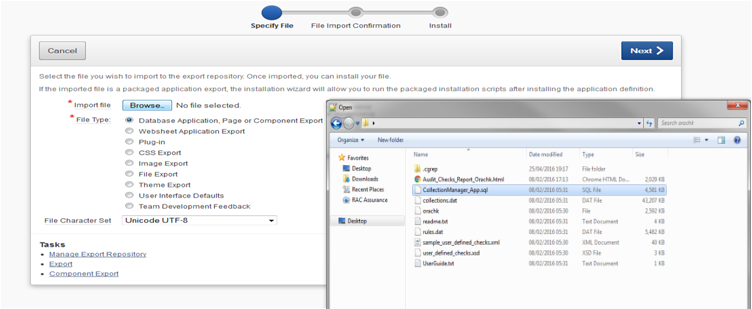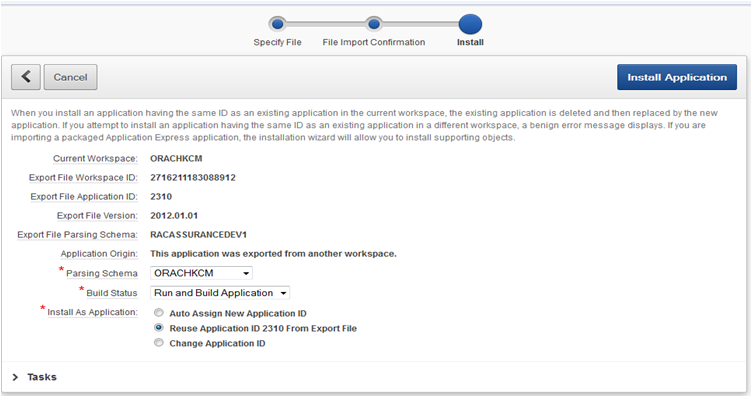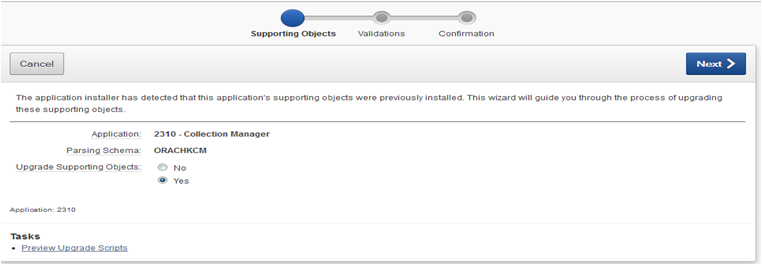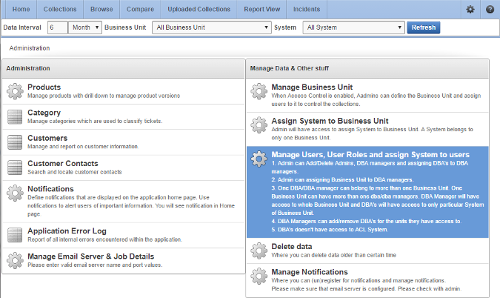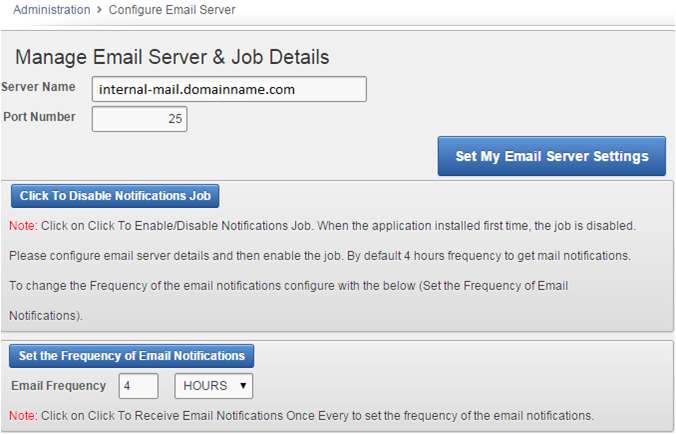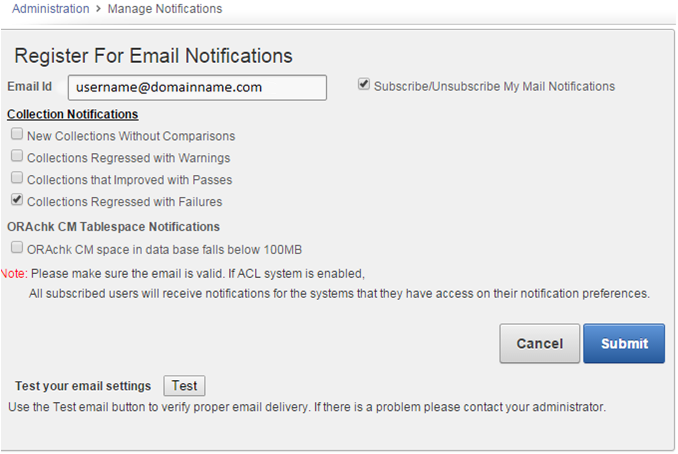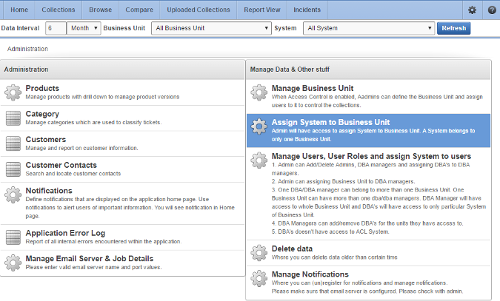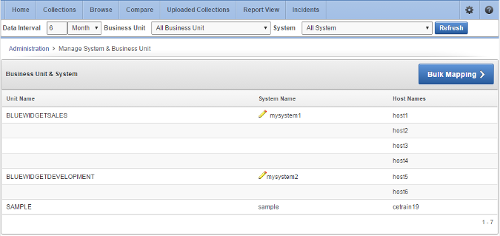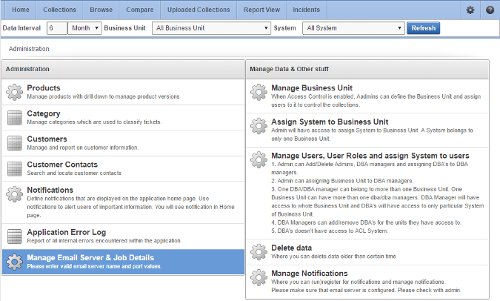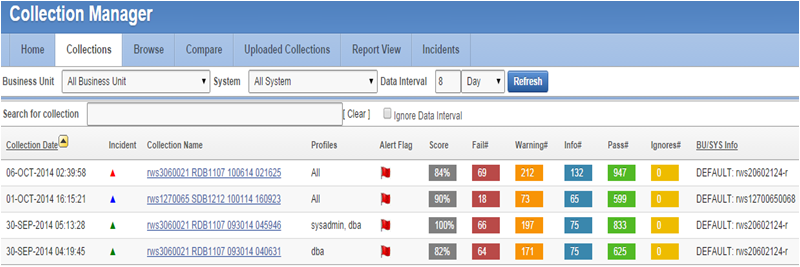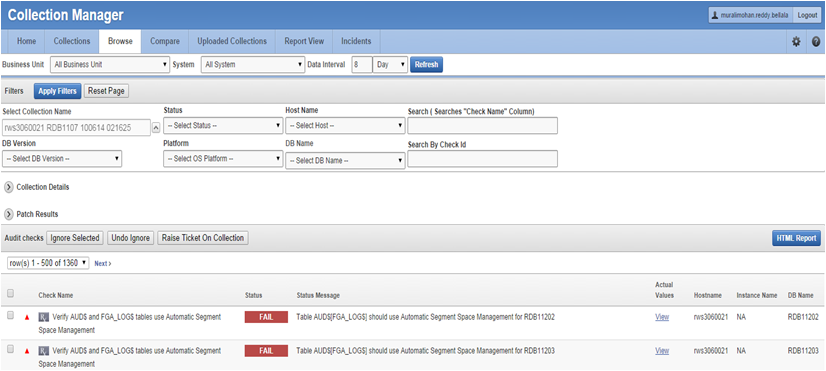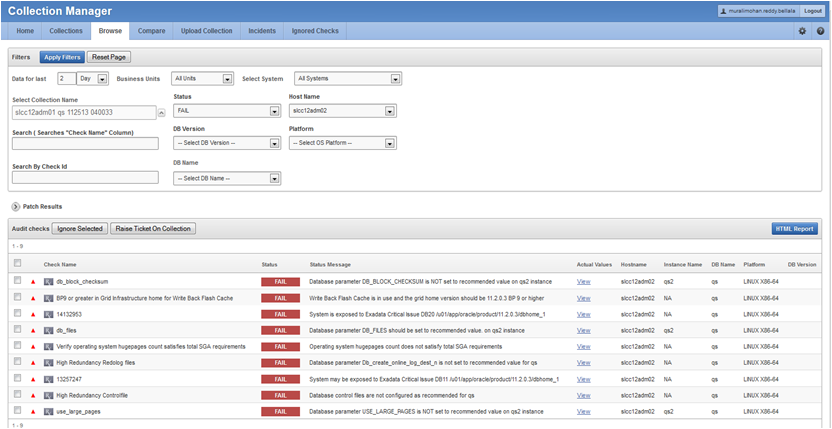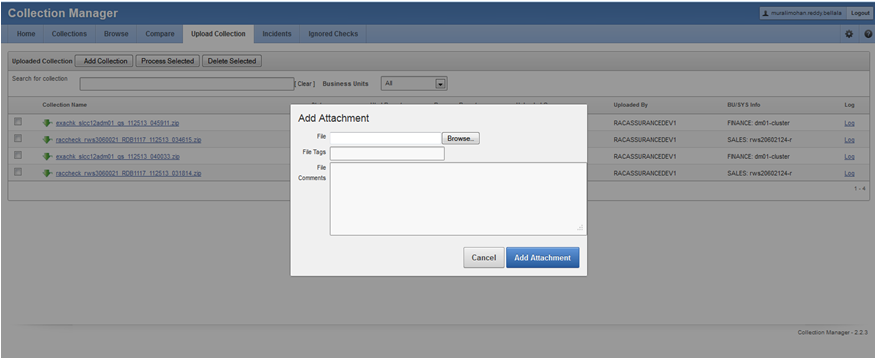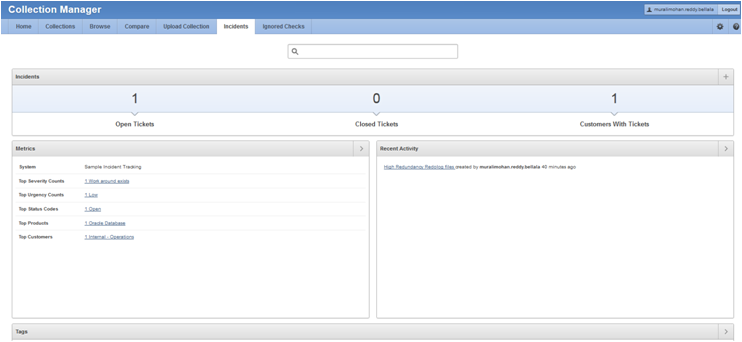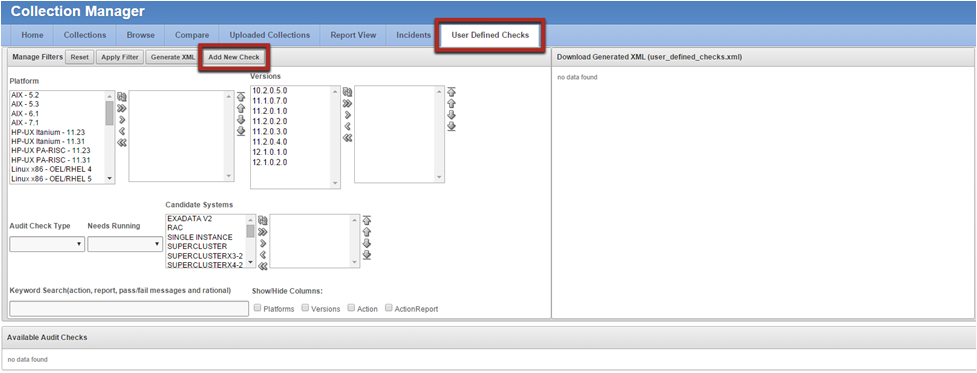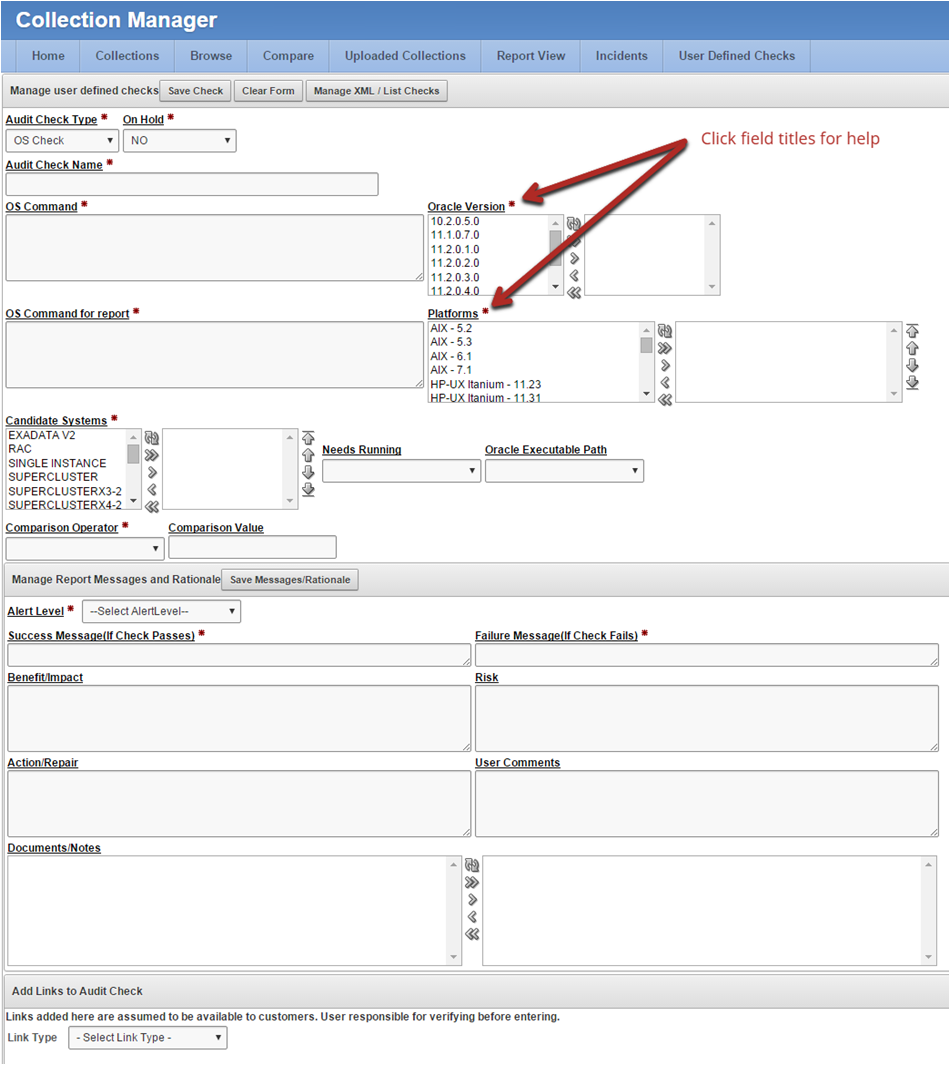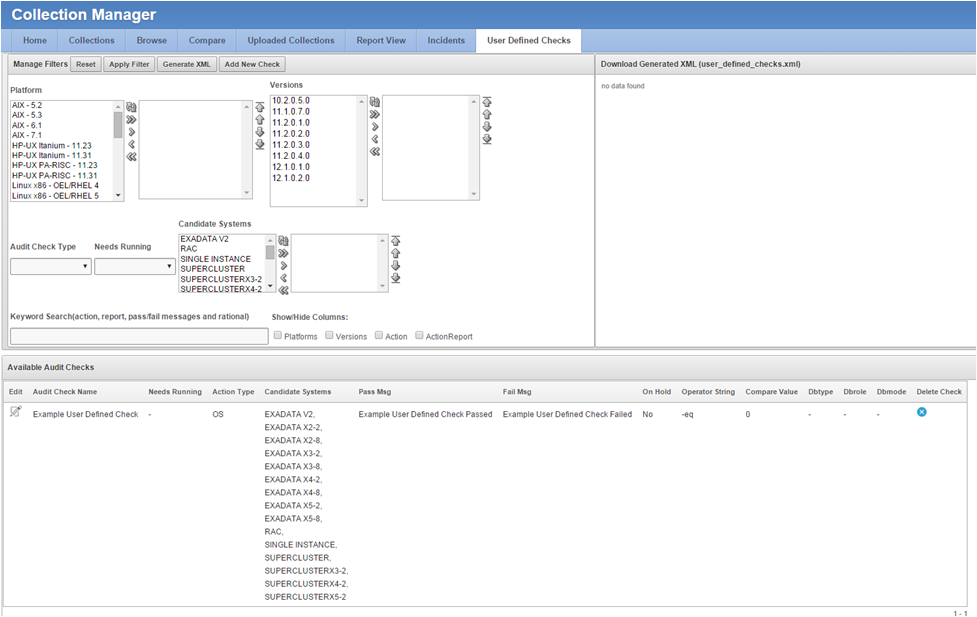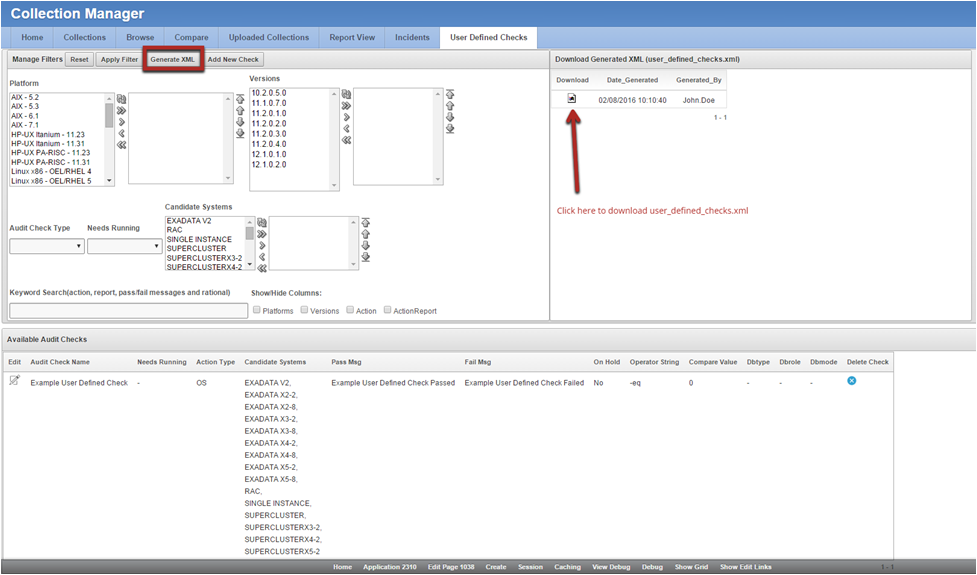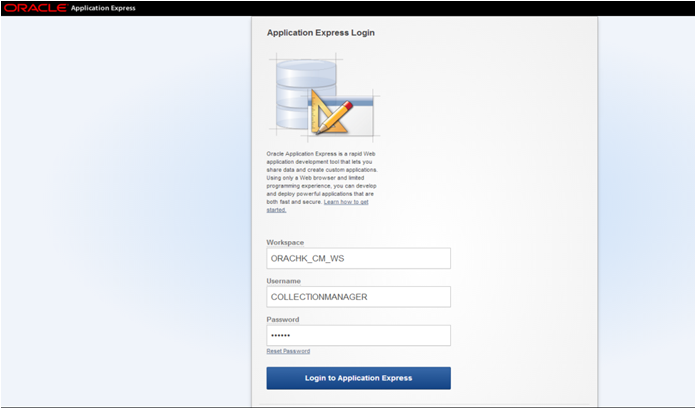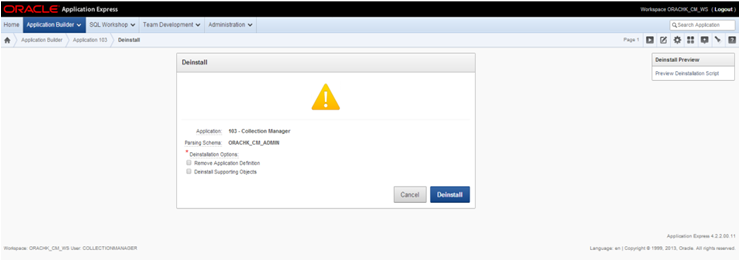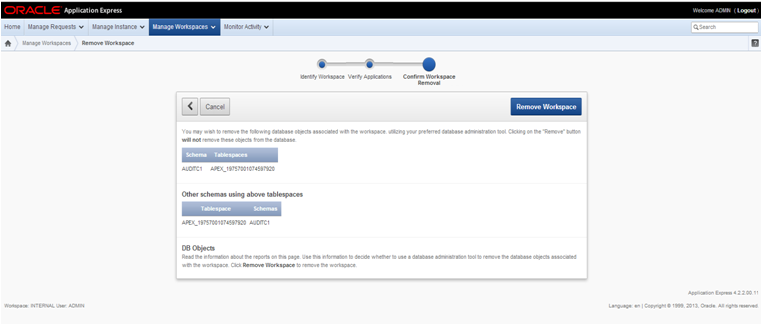1.9 Managing Oracle Health Check Collections Manager
Oracle Health Check Collections Manager is a companion application to Oracle ORAchk and Oracle EXAchk that gives you an enterprise-wide view of your health check collection data.
- Scope and Supported Platforms
Review the support matrix for Oracle Health Check Collections Manager. - Prerequisites
Review the list of Oracle Health Check Collections Manager prerequisites. - Installation
Follow the installation procedures sequentially to successfully install Oracle Health Check Collections Manager. - Upgrading Oracle Health Check Collections Manager Application
Upgrading the Oracle Health Check Collections Manager Application is as simple as a fresh application installation. - Getting Started
Familiarize yourself with the Oracle Health Check Collections Manager Application. - Oracle Health Check Collections Manager Application Features
Familiarize yourself with the features of Oracle Health Check Collections Manager Application. - Oracle Health Check Collections Manager Application Uninstallation
Anytime you can decommission Oracle Health Check Collections Manager Application setup. Follow these steps sequentially to gracefully uninstall the application leaving no residual files. - Troubleshooting Oracle Health Check Collections Manager
This topic describes how to troubleshoot Oracle Health Check Collections Manager.
1.9.1 Scope and Supported Platforms
Review the support matrix for Oracle Health Check Collections Manager.
It is difficult to run health checks and maintain collection data when you have many systems to manage. Oracle Health Check Collections Manager is a companion application to Oracle ORAchk and Oracle EXAchk that gives you an enterprise-wide view of your health check collection data.
Oracle Health Check Collections Manager:
-
Provides a dashboard to track your collection data in one easy-to-use interface
-
Displays collection data based on Business Units and time
-
Serves as an enterprise-wide repository of all collections
-
Uploads collection automatically
Oracle Health Check Collections Manager is fully supported through Oracle Support Services on all Editions (SE1, SE, and EE) of the Oracle database 11.1.0.7 or later with a valid Oracle Database Technical Support agreement.
Use Oracle Application Express 4.2 with Oracle Database 11g R1, 11g R2 and 12c R1. Express Edition (XE) is supported only through the Oracle Technology Network (OTN) discussion forums and not through Oracle Support Services.
1.9.2 Prerequisites
Review the list of Oracle Health Check Collections Manager prerequisites.
-
Oracle Database 11.1.0.7.0 or later.
-
Oracle Application Express 4.2.0 or later.
1.9.3 Installation
Follow the installation procedures sequentially to successfully install Oracle Health Check Collections Manager.
- Configuring Oracle Application Express and Creating a Workspace
Follow these procedures to configure Oracle Application Express and create a workspace. - Install Oracle Health Check Collections Manager Application
Follow these procedures to install Oracle Health Check Collections Manager. - Log in to Oracle Health Check Collections Manager Application
Follow these procedures to log in to Oracle Health Check Collections Manager.
1.9.3.1 Configuring Oracle Application Express and Creating a Workspace
Follow these procedures to configure Oracle Application Express and create a workspace.
- Log in to the Workspace
Follow these procedures to log in to Application Express admin user workspace. - Application Express User Accounts
Application Express provides three types of users, namely, workspace administrators, developers, and end users.
1.9.3.1.1 Log in to the Workspace
Follow these procedures to log in to Application Express admin user workspace.
1.9.3.1.2 Application Express User Accounts
Application Express provides three types of users, namely, workspace administrators, developers, and end users.
Table 1-14 Application Express Types of Users
| Type of User | Description |
|---|---|
|
Workspace administrators |
Workspace administrators can additionally create and edit user accounts, manage groups, and manage development services. |
|
Developers |
Developers can create and modify applications and database objects. |
|
End users |
End users are non-administrative who have no development privileges and can only access applications that do not use an external authentication scheme. For the Oracle Health Check Collections Manager Application, almost all of the users fall into this category. A special role within the Oracle Health Check Collections Manager Application, DBA Managers and the DBAs manage all application users. |
To grant access to the Oracle Health Check Collections Manager Application for non-administrative users (End users), you must login to the Workspace as an Admin user.
1.9.4 Upgrading Oracle Health Check Collections Manager Application
Upgrading the Oracle Health Check Collections Manager Application is as simple as a fresh application installation.
1.9.5 Getting Started
Familiarize yourself with the Oracle Health Check Collections Manager Application.
- Incident Ticket System Lookup Lists and Seed Data
The Oracle Health Check Collections Manager Application provides a basic Incident Ticket system and is deployed with seed data for the lookup lists used for data entry for incident tickets: - Access Control System
Limit and control access based on functional roles. - Oracle Health Check Collections Manager Application Administration
Grant sufficient privileges to different roles to restrict authorized users alone to access the application. - Selectively Capturing Users During Login
By default, Oracle Health Check Collections Manager captures details of the users logging in using LDAP authentication, and assigns them DBA role. However, you can disable automatic capture and re-enable anytime later. If you disable, then you must manually create users and assign them roles. - Configuring Email Notification System
The Oracle Health Check Collections Manager Application provides an email notification system that users can subscribe to. - Bulk Mapping Systems to Business Units
If you have a large number of systems, then you can quickly map those systems to business units in Oracle Health Check Collections Manager using an XML bulk upload. - Purging Old Collections
By default, Oracle Health Check Collections Manager purges collections older than three months.
1.9.5.1 Incident Ticket System Lookup Lists and Seed Data
The Oracle Health Check Collections Manager Application provides a basic Incident Ticket system and is deployed with seed data for the lookup lists used for data entry for incident tickets:
-
Products
-
Category
-
Customer Contacts
-
Notifications
-
Status Codes
-
Incident Severity
-
Incident Urgency
The seed data is values that are commonly used. Add or change the seed data provided with the application. However, you need to have admin privileges to manage the seed data through the Administration tab. Click the “gear” icon at the upper-right corner to access the Administration tab.
1.9.5.2 Access Control System
Limit and control access based on functional roles.
By default, the Access Control system is disabled. If Access Control is disabled, then all authenticates users are granted admin user privileges and can access all application features. Manage the Access Controls through the Administration tab to assign one or more roles to the end users. You can enable the following three functional roles available in the Oracle Health Check Collections Manager.
-
Admin: Admin role user may or may not be a Workspace Administrator for the application and it depends on your functional roles requirements.
-
DBA Manager
-
DBA
Assign role to the users after configuring the Access Control system.
1.9.5.3 Oracle Health Check Collections Manager Application Administration
Grant sufficient privileges to different roles to restrict authorized users alone to access the application.
Admin
Any end user who is granted an admin role by the workspace administrator will have an admin user privileges within the Collection Manager application.
http://hostname:port/apex/f?p=ApplicationID http://hostname:port/pls/apex/f?p=ApplicationID)For example:
http://dbserver.domain.com:8080/apex/f?p=103
As an admin user, you must see the Administration menu (gear icon) at the upper-right corner. Click this icon to go to the Administration page.
-
Following are the admin user privileges:
-
Add or revoke admin privileges
-
Define Business Units (BU)
-
Assign DBA Manager role to users
-
Assign DBA Managers to one or more BUs
-
Assign systems to BUs (a system can belong to one BU)
-
Assign DBAs to DBA Managers
-
Assign systems to DBAs
-
Ignore any check on a collection, BU or system
-
Create and assign incidents to any user
-
Manage all incidents
Figure 1-78 Oracle Health Check Collections Manager - Administration
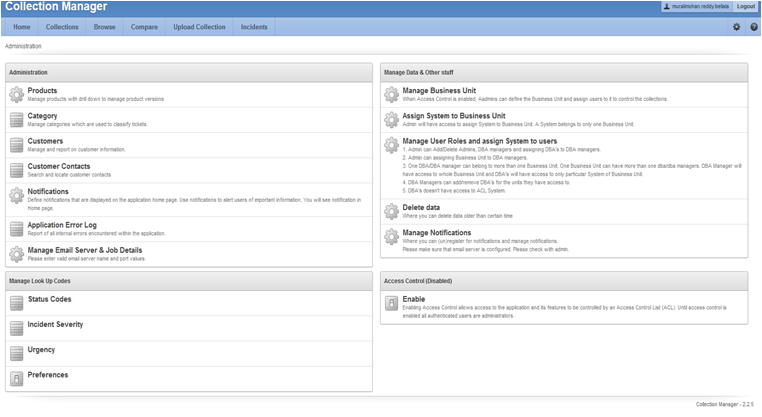
Description of "Figure 1-78 Oracle Health Check Collections Manager - Administration" -
-
Only Admin role can edit any section under the Administration menu.
-
The admin users need to configure data based on their requirements under the administration menu to prepare for the wider usage of the application. This is a one-time activity, however, change the configuration over time to suit your needs.
Examples of the configuration data that you need set up are:
-
Products
-
Customers (internal designations for workgroups)
-
Categories
-
Notifications
-
Status codes
-
Manage Email Server and Job details
-
Manage Notifications
-
Incident Severity
-
Urgency
-
Manage User Roles and Assign systems to users
-
Business Units (BUs)
-
Assign systems to BUs
-
DBA Manager
Any user who is granted the DBA Manager role.
http://hostname:port/apex/f?p=ApplicationID http://hostname:port/pls/apex/f?p=ApplicationID)
The DBA Managers must see an Administration menu (gear icon) at the upper-right corner of the application.
Figure 1-79 Oracle Health Check Collections Manager - DBA Manager Administration

Description of "Figure 1-79 Oracle Health Check Collections Manager - DBA Manager Administration"
Click Manage User Roles.
Figure 1-80 Oracle Health Check Collections Manager - DBA Manager - Manage User Roles
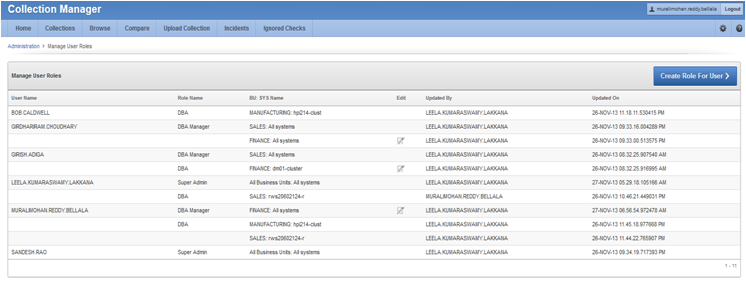
Description of "Figure 1-80 Oracle Health Check Collections Manager - DBA Manager - Manage User Roles"
In above sample screen, user Murali has a DBA Manager role to the Finance BU. The DBA Manager can edit user roles or assign systems to other users in his or her BU. The scope of a DBA Manager is an entire BU, or multiple BUs.
-
Assign DBAs to BUs the manager manages
-
Assign DBAs to one or more systems
-
Ignore any check on a collection, BU or system
-
Create incidents for any system
-
Assign incidents to DBAs that manage the systems in their BUs
-
Manage any incidents for systems within their assigned BUs
DBA
Any user who is granted the DBA role.
http://hostname:port/apex/f?p=ApplicationID http://hostname:port/pls/apex/f?p=ApplicationID)
The DBA must see the Administration menu (gear icon) at the upper-right corner of the application.
Any end user granted an admin role by the workspace administrator will have an admin user privileges within the Collection Manager application.
Figure 1-81 Oracle Health Check Collections Manager - DBA Administration

Description of "Figure 1-81 Oracle Health Check Collections Manager - DBA Administration"
Click Manage User Roles.
DBA user has read-only access.
Figure 1-82 Oracle Health Check Collections Manager - DBA - Manage User Roles

Description of "Figure 1-82 Oracle Health Check Collections Manager - DBA - Manage User Roles"
In above sample screen, user Murali has a DBA Role to hpi214-clust system under the Manufacturing BU. However, he cannot edit user roles and assign system to other users.
-
Cannot manage Access Control List
-
Manage systems within one or more BUs, if the DBA Managers of those BUs assigns them
-
Ignore any check on a collection or system they manage
-
Manage any incidents assigned to them
1.9.5.4 Selectively Capturing Users During Login
By default, Oracle Health Check Collections Manager captures details of the users logging in using LDAP authentication, and assigns them DBA role. However, you can disable automatic capture and re-enable anytime later. If you disable, then you must manually create users and assign them roles.
1.9.5.5 Configuring Email Notification System
The Oracle Health Check Collections Manager Application provides an email notification system that users can subscribe to.
-
Configuring the email server, port, and the frequency of email notifications.
-
Registering the email address
Note:
Only Admin role users has the privilege to manage Email Notification Server and Job details.
Note:
Manage Notifications section under the Administration menu is available for all users irrespective of the role.
If the ACL system is enabled, then the registered users receive notifications for the systems that they have access to. If the ACL system is not configured, then all registered users receive all notifications.
Depending on the selection(s) you made under Collection Notifications section, you receive an email with Subject: Collection Manager Notifications containing application URL with results.
Figure 1-90 Oracle Health Check Collections Manager - Sample Email Notification

Description of "Figure 1-90 Oracle Health Check Collections Manager - Sample Email Notification"
Under Comments column, click the Click here links for details. Click the respective URLs, authenticate and then view respective comparison report.
Figure 1-91 Oracle Health Check Collections Manager - Sample Diff Report

Description of "Figure 1-91 Oracle Health Check Collections Manager - Sample Diff Report"
1.9.5.6 Bulk Mapping Systems to Business Units
If you have a large number of systems, then you can quickly map those systems to business units in Oracle Health Check Collections Manager using an XML bulk upload.
1.9.6 Oracle Health Check Collections Manager Application Features
Familiarize yourself with the features of Oracle Health Check Collections Manager Application.
- Global Select Lists
Collection Manager Application has an option to display the data based on select lists like Business Units, Systems and Data for last periods of time. - Home Tab
Displays systems and their statuses, and recent activities of all users who has permission to access the application. - Collections Tab
Displays incidence information for each collection, and collection score for failed, warning, and failed checks. - Browse Tab
Allows you to list individual checks based on filters set. - Compare Tab
Helps you compare audit check results and patch results. - Report View Tab
Provides a graphical representation of database checks, instance checks, home path checks, and system health checks. - Upload Collections Tab
Provides an interface to manually upload a collection into Oracle Health Check Collections Manager Application and provides a list of uploaded collections and file details. - Uploading Collections Automatically
Configure Oracle ORAchk and Oracle EXAchk to automatically upload check results to the Oracle Health Check Collections Manager database. Specify the connection string and the password to connect to the database and upload collection results. Oracle Health Check Collections Manager stores the connection details in an encrypted wallet. - Viewing and Reattempting Failed Uploads
Use these procedures to view and reattempt to upload the failed uploads. - Tracking Support Incidents
The Incidents tab gives you a complete system for tracking support incidents. - Authoring User-Defined Checks
User-defined checks are checks written, tested, verified and maintained by you that are specific to your environment.
1.9.6.1 Global Select Lists
Collection Manager Application has an option to display the data based on select lists like Business Units, Systems and Data for last periods of time.
All these select lists are global within the application and options available on starting of each tab.
-
Business Unit
-
System
-
Data interval
1.9.6.2 Home Tab
Displays systems and their statuses, and recent activities of all users who has permission to access the application.
-
Displays systems and their statuses in graphs with color coded green, orange, and red based on check results (passed, warning, and failed).
-
The Home tab has an option to display the data based on select lists like Business Units and Data for last periods of time. There is also an option to filter the most failed/warned checks and recent collections based on system name.
-
The Most Failed Checks region displays information for the most frequently failed checks for all collections for the time period, Business Unit or System selected, and displays the check name, fail count. There is a similar region for most warned checks .
-
The Recent Collections region displays brief information about recently uploaded collections based on time frame, Overall score with Fail, Warning, and Pass counts and a Status flag. Recent collections are automatically compared to the last collection from the same system, whenever it occurred, if there is one.
Status Flags are color-coded green, orange or red based on the comparison between the recent collection and the last collection, if any.
-
GREEN: There is no difference at all between the two collections or one or more findings from the last collection improved from WARNING or FAIL to PASS or there was no earlier collection to compare with.
-
ORANGE: There were one or more regressions between the last collection and the most recent on a given system. In other words some findings transitioned in a negative way, for example, PASS to WARNING.
-
RED: There were one or more regressions between the last collection and the most recent on a given system. In other words some findings transitioned in a negative way, for example, PASS to FAIL.
-
-
Recent Activity in User Range shows recent activities by all users across all collections specific to the access role granted the user.
-
DBA role user able to see everything within his/her systems which he or she assigned.
-
DBA Manager role user able to see everything within his or her Business Unit and Systems which he or she assigned.
-
Admin role user can see everything when you have a collection data uploaded in to the application.
-
1.9.6.3 Collections Tab
Displays incidence information for each collection, and collection score for failed, warning, and failed checks.
-
Displays all collections and allows you to filter the list of collections based on Business units and System. You can also filter based on Status flag. The list is also inherently filtered to those collections the user has access to, based on their assigned role.
-
Displays incident information for each collection indicated by Delta (Δ) color coded red, blue, and green based on ticket status. Click the delta symbol to raise a new ticket or alter the ticket for an entire collection.
-
RED (No Incident ticket exists): Click to create a new incident ticket for the collection or individual checks.
-
BLUE (An open Incident ticket exists): Click to open the incident ticket for editing.
-
GREEN (A closed Incident ticket exists): Click opens the closed incident ticket for viewing.
-
-
Collection Score is calculated based on failed, warning, and passed checks.
If a user raised a ticket for the collection, resolved the issues and the ticket is closed signifying the issues have all been resolved, then Oracle Health Check Collections Manager changes the collection score to 100%.
If a user raised a ticket for an individual check and if it is closed signifying that the finding has been resolved, then Oracle Health Check Collections Manager changes the status of the check as PASS and recalculates the collection score.
Collection Score is derived using following formula.
-
Every check has 10 points.
-
Failure deducts 10 points.
-
Warning deducts 5 points.
-
Info deducts 3 points.
-
-
A More Info link next to a collection indicates the collection was manually uploaded into the application.
-
Click the linked collection name in the list to load the collection in the Browse tab.
1.9.6.4 Browse Tab
Allows you to list individual checks based on filters set.
-
Set filters once the list of checks is created.
-
Create and alter incident tickets for individual audit check findings similar to as described in the Collections tab.
-
Select checks to ignore and to undo previously ignored checks. Select the checkbox beside the audit check and click Ignore Selected. Collection Manager marks them as FAIL-IGNORED, indicating that the check had failed but is ignored.
Oracle Health Check Collections Manager ignores the checks for the entire level based on the level selected for ignoring.
To ignore selected failed checks, you must choose the ignore type from the following list:
-
ignore from collection
-
ignore from system
-
ignore from a business unit
-
ignore from all business units
Note:
The domain for ignoring checks is within the role assigned to the user.
All Ignored checks are listed under the Ignored Checks tab, if needed undo ignore.
To undo the selected Ignored checks, consider the type from the following list:
-
undo ignore from collection
-
undo ignore from system
-
undo ignore from business unit
-
undo ignore from all business units
Note:
The domain for undoing ignored checks is within the role assigned to the user.
-
Figure 1-102 Browse Tab - Apply Filters - Ignored Checks
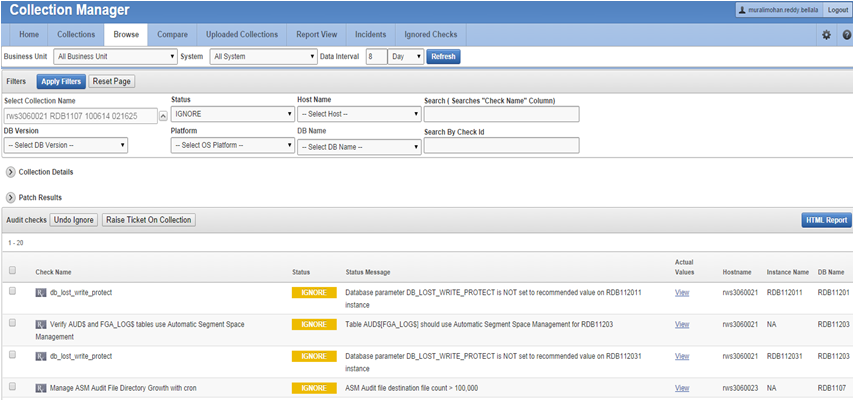
Description of "Figure 1-102 Browse Tab - Apply Filters - Ignored Checks"
1.9.6.5 Compare Tab
Helps you compare audit check results and patch results.
-
Compare Audit check Results
-
Compare the audit check findings from two different collections based on Business Unit, System, DB Version and Platform. The collections available for comparison are limited to filters set.
-
Compare collections from the same or different systems.
-
-
Compare Patch Results
-
Compare installed Oracle patches from two different collections. The comparison displays the difference between the two collections based on patch results.
-
Figure 1-104 Compare Tab - Audit Checks Diff
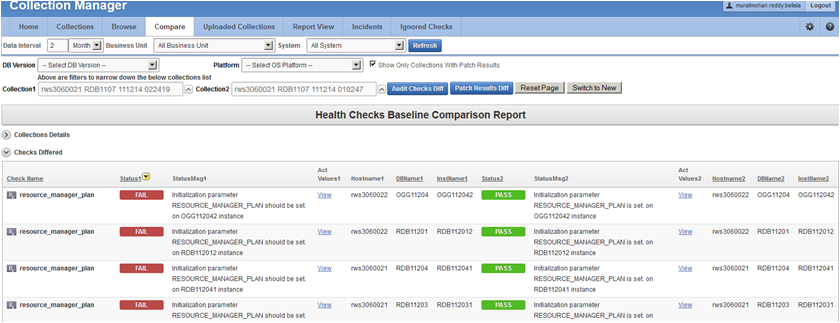
Description of "Figure 1-104 Compare Tab - Audit Checks Diff"
Figure 1-105 Compare Tab - Patch Results Diff

Description of "Figure 1-105 Compare Tab - Patch Results Diff"
Note:
Row highlighted with blue color that the patch is recommended, but it is not installed in one of the collections.
1.9.6.6 Report View Tab
Provides a graphical representation of database checks, instance checks, home path checks, and system health checks.
-
Provides a printable view option to print the graphical summary of system collection
-
Displays separate graphical summary view for database checks, instance checks and home path checks breakup based on check type and check status in collection
-
Displays system health check details based on status and check type in collection
1.9.6.7 Upload Collections Tab
Provides an interface to manually upload a collection into Oracle Health Check Collections Manager Application and provides a list of uploaded collections and file details.
These manually uploaded collections are unzipped and their data imported into the framework just as if they had been uploaded at runtime when the tool was run. Therefore, even if the tool is not configured for automatic upload into the Oracle Health Check Collections Manager Application, you can always upload collections manually.
Note:
Using a combination of tables and environment variables, you can automate the process of uploading collections into the database hosting the Collection Manager Application at runtime.
1.9.6.8 Uploading Collections Automatically
Configure Oracle ORAchk and Oracle EXAchk to automatically upload check results to the Oracle Health Check Collections Manager database. Specify the connection string and the password to connect to the database and upload collection results. Oracle Health Check Collections Manager stores the connection details in an encrypted wallet.
Oracle ORAchk and Oracle EXAchk –setdbupload all
–setdbupload option. For default options, use –setdbupload all.
./orachk -setdbupload all
./exachk -setdbupload all
Oracle Health Check Collections Manager prompts you to enter the values for the connection string and password. Oracle Health Check Collections Manager stores these values in an encrypted wallet file.
Oracle ORAchk and Oracle EXAchk –getdbupload all
–getdbupload option.
$ ./orachk –getdbupload
$ ./exachk –getdbupload
Oracle ORAchk and Oracle EXAchk can automatically use the default values set in the RAT_UPLOAD_USER and RAT_ZIP_UPLOAD_TABLE environment variables.
Oracle ORAchk and Oracle EXAchk –checkdbupload all
$ ./orachk –checkdbupload
$ ./exachk –checkdbupload
Example 1-6 Oracle ORAchk and Oracle EXAchk –setdbupload all
$ ./orachk -setdbupload all
Enter value for RAT_UPLOAD_CONNECT_STRING:(DESCRIPTION=(ADDRESS=(PROTOCOL=TCP)(HOST=myserver44.acompany.com)(PORT=1521))(CONNECT_DATA=(SERVER=DEDICATED)(SERVICE_NAME=orachkcm.acompany.com))) Enter value for RAT_UPLOAD_PASSWORD:****** Database upload parameters successfully stored in orachk_wallet. orachk run will keep uploading the collections in database until it is unset using ./orachk -unsetdbupload all/env <variable name>
Note:
Use the fully qualified address (as in the example above) for the connect string rather than an alias from the tnsnames.ora file so that it is not necessary to rely on tnsnames.ora file name resolution on all the servers where the tool might be run.
Example 1-7 Oracle ORAchk and Oracle EXAchk –getdbupload all
$ ./orachk -getdbupload RAT_UPLOAD_CONNECT_STRING = (DESCRIPTION=(ADDRESS=(PROTOCOL=TCP)(HOST=myserver44.acompany.com)(PORT=1521))(CONNECT_DATA=(SERVER=DEDICATED)(SERVICE_NAME=orachkcm.acompany.com))) RAT_UPLOAD_PASSWORD = ****** RAT_UPLOAD_USER = ORACHKCM RAT_ZIP_UPLOAD_TABLE = RCA13_DOCS
Example 1-8 Oracle ORAchk and Oracle EXAchk –checkdbupload all
$ ./orachk -checkdbupload Configuration is good to upload result to database.
At the end of health check collection, Oracle ORAchk and Oracle EXAchk check if the required connection details are set (in the wallet or the environment variables). If the connection details are set properly, then Oracle ORAchk and Oracle EXAchk upload the collection results.
Tip:
To configure many Oracle ORAchk and Oracle EXAchk instances:
-
Create the wallet once with the
-setdbupload alloption, then enter the values when prompted. -
Copy the resulting wallet directory to each Oracle ORAchk and Oracle EXAchk instance directories.
You can also set the environment variable RAT_WALLET_LOC to point to the location of the wallet directory.
-
RAT_UPLOAD_USER: controls which user to connect as (default is
ORACHKCM). -
RAT_UPLOAD_TABLE: controls the table name to store non-zipped collection results in (not used by default).
-
RAT_PATCH_UPLOAD_TABLE: controls the table name to store non-zipped patch results in (not used by default).
-
RAT_UPLOAD_ORACLE_HOME: controls ORACLE_HOME used while establishing connection and uploading.
By default, ORACLE_HOME is set to Oracle Grid Infrastructure
HOMEdiscovered by Oracle ORAchk and Oracle EXAchk.
RCA13_DOCS: is not configurable to use Oracle Health Check Collections Manager as this is the table Oracle Health Check Collections Manager looks for.
RAT_UPLOAD_TABLE and RAT_PATCH_UPLOAD_TABLE: are not used by default because the zipped collection details are stored in RCA13_DOCS.
You only need to configure RAT_UPLOAD_TABLE and RAT_PATCH_UPLOAD_TABLE variable if you are using your own custom application to view collection results.
$ ./orachk -setdbupload all
$ ./exachk -setdbupload all
This will prompt you for and set the RAT_UPLOAD_CONNECT_STRING and RAT_UPLOAD_PASSWORD, then use
$ ./orachk -setdbupload RAT_PATCH_UPLOAD_TABLE,RAT_PATCH_UPLOAD_TABLE
$ ./exachk -setdbupload RAT_PATCH_UPLOAD_TABLE,RAT_PATCH_UPLOAD_TABLE
Note:
export RAT_UPLOAD_CONNECT_STRING=”(DESCRIPTION=(ADDRESS=(PROTOCOL=TCP)(HOST=myserver.acompnay.com)(PORT=1521))(CONNECT_DATA=(SERVER=DEDICATED)(SERVICE_NAME=myservice.acompany.com)))”
1.9.6.9 Viewing and Reattempting Failed Uploads
Use these procedures to view and reattempt to upload the failed uploads.
Values are stored in collection_dir/outfiles/check_env.out to record if the previous database upload was successful or not.
DATABASE_UPLOAD_SETUP=1 DATABASE_UPLOAD_STATUS=0
Oracle ORAchk and Oracle EXAchk -checkfaileduploads
-checkfaileduploads option:
./orachk -checkfaileduploads
./exachk -checkfaileduploads
$ ./orachk -checkfaileduploads List of failed upload collections /home/oracle/orachk_myserver_042016_232011.zip /home/oracle/orachk_myserver_042016_231732.zip /home/oracle/orachk_myserver_042016_230811.zip /home/oracle/orachk_myserver_042016_222227.zip /home/oracle/orachk_myserver_042016_222043.zip
Oracle ORAchk and Oracle EXAchk -uploadfailed
-uploadfailed option, specifying either all to upload all or a comma-delimited list of collections:
./orachk -uploadfailed all|list of failed collections
./exachk -uploadfailed all|list of failed collections
./orachk -uploadfailed "/home/oracle/orachk_myserver_042016_232011.zip, /home/oracle/orachk_myserver_042016_231732.zip"
Note:
You can not upload previously uploaded collections because of the SQL unique constraint.
1.9.6.10 Tracking Support Incidents
The Incidents tab gives you a complete system for tracking support incidents.
-
Enter customers and multiple contacts for each customer, specify products and categories, and set up values to limit status codes, severity, and urgency attributes for an incident.
-
Raise a new ticket by clicking the Delta (Δ) symbol. Oracle Health Check Collections Manager displays this symbol only in the Collections and Browse tabs.
-
The Browse tab allows the user to create a new ticket on individual checks.
-
The Collections tab allows the user to create a single ticket for entire the collection.
-
Delta (Δ) symbol is color coded red, blue, and green based on the ticket status.
-
RED (No Incident ticket exists): initiates the process to create a new incident ticket for the collection or individual checks.
-
BLUE (An open Incident ticket exists): opens the incident ticket for editing.
-
GREEN (A closed Incident ticket exists): opens the closed incident ticket for viewing.
-
-
Once a ticket is entered into the system, you can track the progress of the ticket in an update area of the ticket, or add attachments and links to the incident. You can also use tags to further classify incidents and use the resulting tag cloud in your reports.
-
Incident access and management can happen only within user's access control range.
Note:
Incident Tracking feature of Oracle Health Check Collections Manager Application is a basic stand-alone system and is not designed for integration with other commercial enterprise level trouble ticketing systems.
Incident Tracking Features
-
Search options
-
Track and analyze incident tickets
-
Flexible and updateable incident status
-
Robust reporting
-
Link, Note, and File Attachments
-
Flexible Access Control (reader, contributor, administrator model)
- Incidents Tab
Create or edit incident tickets for individual checks or for an entire collection. The statuses of each ticket is represented by icons with different colors. You can act upon by clicking those icons.
1.9.6.10.1 Incidents Tab
Create or edit incident tickets for individual checks or for an entire collection. The statuses of each ticket is represented by icons with different colors. You can act upon by clicking those icons.
- Creating Incident Tickets
Follow these procedures to create incident tickets. - Editing Incident Tickets
Follow these procedures to edit incident tickets.
1.9.6.10.1.1 Creating Incident Tickets
Follow these procedures to create incident tickets.
- Click the Delta (Δ) symbol colored RED.
- Add your ticket details.
- Click Next.
- Select the Product and Product Version.
- Click Next.
- Select the Urgency of the ticket.
- Select the Severity of the ticket.
- Select the Status of the ticket.
- Select the Category of the ticket.
- Enter a summary and description of the incident.
- Click Create Ticket.
1.9.6.10.1.2 Editing Incident Tickets
Follow these procedures to edit incident tickets.
- Click the Incident tab.
- Click Open Tickets.
- Click the ticket.
- Click Edit Ticket.
- Alter required details, click Apply Changes.
Note:
Click the delta symbol colored GREEN in the Collections or Browse tabs to edit incident tickets.1.9.6.11 Authoring User-Defined Checks
User-defined checks are checks written, tested, verified and maintained by you that are specific to your environment.
Oracle supports the framework for the creating and running user-defined checks, but not the logic of the checks. It is your responsibility to test, verify, author, maintain and support these checks. The checks are run at runtime by the Oracle ORAchk and Oracle EXAchk script and displays the results of the user-defined checks in the User Defined Checks section of the HTML report.
The user-defined checks are stored in the Oracle Health Check Collections Manager schema and output to an XML file, which is co-located with the ORAchk script. When ORAchk 12.1.0.2.5 and later run on your system, it checks for the presence of this XML file and if it finds one, then by default it will run the checks contained therein and include the results in the standard HTML report.
Related Topics
1.9.7 Oracle Health Check Collections Manager Application Uninstallation
Anytime you can decommission Oracle Health Check Collections Manager Application setup. Follow these steps sequentially to gracefully uninstall the application leaving no residual files.
- Deleting Oracle Health Check Collections Manager Application
You need administrative privileges to uninstall Oracle Health Check Collections Manager Application. After successful uninstallation, application definition and the supporting objects are deleted from the hosting database. - Deleting Workspace Admin
You need administrative privileges to delete a workspace. There may exist one or more workspaces so be cautious while deleting workspaces.
1.9.7.1 Deleting Oracle Health Check Collections Manager Application
You need administrative privileges to uninstall Oracle Health Check Collections Manager Application. After successful uninstallation, application definition and the supporting objects are deleted from the hosting database.
1.9.7.2 Deleting Workspace Admin
You need administrative privileges to delete a workspace. There may exist one or more workspaces so be cautious while deleting workspaces.
The install process displays the Workspace has been successfully removed message.
See Also:
Oracle Application Express Installation Guide for more details about uninstallation:
1.9.8 Troubleshooting Oracle Health Check Collections Manager
This topic describes how to troubleshoot Oracle Health Check Collections Manager.
-
If you see any error like,
error at line 13: PLS-00201: identifier 'UTL_SMTP' must be declaredin the Installation Summary, then grant execute onUTL_SMTPprivilege to the parsing schema or workspace owner. -
If there is a requirement to download files from within the Oracle Health Check Collections Manager, then two additional steps are required. Note that these steps are NOT required to upload files into Oracle Health Check Collections Manager.
Prior to installing the Oracle Health Check Collections Manager, run the DDL mentioned below to re-create the Application Express built-in function
WWV_FLOW_EPG_INCLUDE_MOD_LOCALin theAPEX_XXXXXorFLOW_XXXXXXschema whichever is appropriate to your environment. After re-creating the function ensure that it is in VALID state.CREATE OR replace FUNCTION Wwv_flow_epg_include_mod_local( procedure_name IN VARCHAR2) RETURN BOOLEAN IS BEGIN RETURN TRUE; ----- It should be always “RETURN TRUE” IF Upper(procedure_name) IN ( '' ) THEN RETURN TRUE; ELSE RETURN FALSE; END IF; END Wwv_flow_epg_include_mod_local;Once the Oracle Health Check Collections Manager is installed, run
RCA13_GET_DOCto enable file downloads:SQL> grant execute on RCA13_GET_DOC to public;
-
Ensure that Oracle Application Express is installed successfully. If you have revoked any default system privileges from default Application Express users, then grant them again.
-
Ensure that all of the Oracle Application Express related users are not locked and expired.
alter user ANONYMOUS account unlock; alter user XDB account unlock; alter user APEX_PUBLIC_USER account unlock; alter user FLOWS_FILES account unlock;
-
If you see any issues in setting up email notifications, then cross verify your ACL permissions and privileges to the application schema on the SMTP mail server.
For example, to create ACL system and grant privileges to Application schema, do as follows:
BEGIN DBMS_NETWORK_ACL_ADMIN.CREATE_ACL(acl => 'apex1.xml', description => 'APEX ACL', principal => 'ORACHK CM USERNAME', is_grant => true, privilege => 'connect'); DBMS_NETWORK_ACL_ADMIN.ADD_PRIVILEGE(acl => 'apex1.xml', principal => 'ORACHK CM USERNAME', is_grant => true, privilege => 'resolve'); DBMS_NETWORK_ACL_ADMIN.ASSIGN_ACL(acl => 'apex1.xml', host => 'mailservername.com',lower_port=>10,upper_port=>1000); END; / COMMIT; -
If you see any uploaded collection processing is not started or collection status is NEW for long time, then verify database scheduler jobs (
RCA13_PROCESS_DATAandRCA13_COLLECTION_3718) status and ensure that the jobs are enabled and running fine.select * from user_scheduler_jobs where job_name like 'RCA13_13%'; select * from user_scheduler_running_jobs where job_name like 'RCA13_%' select * from user_scheduler_job_run_details where job_name like 'RCA13_%' order by log_date desc;
-
If you see collection process is failed due to lack of space in Oracle Application Express tablespace and application schema tablespace, then increase the tablespace sizes as much as needed.
